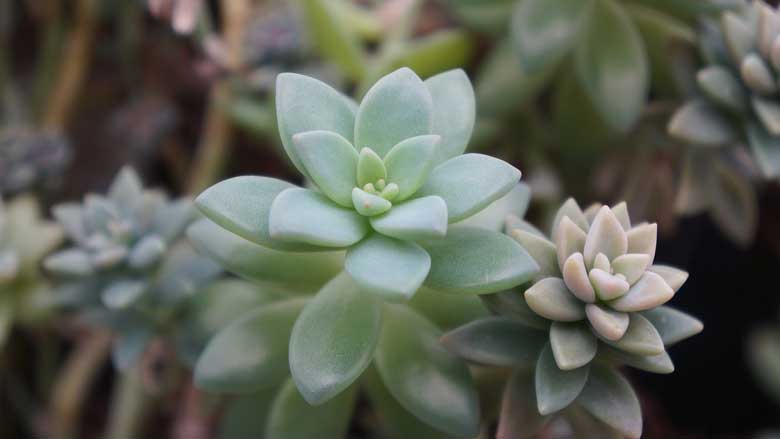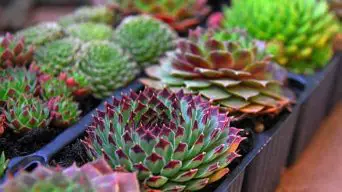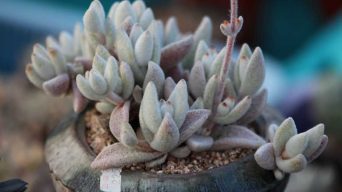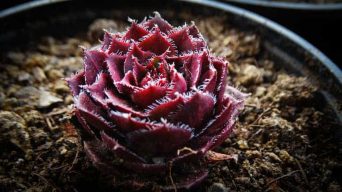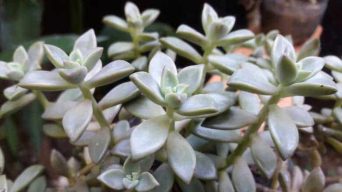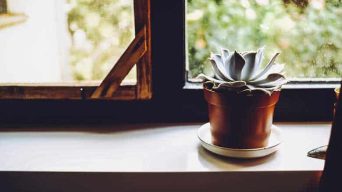Bring succulents inside before the first frost, generally at the end of September or when nighttime temperatures consistently fall below 50°F. For tropical varieties, move indoors as nighttime temperatures drop into the 40s.
Succulents are a beautiful addition to any home. They can be kept outside in the summer when the weather is mild.
With the change of season and the colder weather around the corner, many people start bringing their plants indoors.
However, when it comes to succulent plants, some things need to be considered before doing so.
While succulents can handle the temperature change indoors, they require special care.
Proper preparation and understanding when it is time will help you keep your succulent plant happy when bringing it inside for winter!
Understanding the Need to Bring Succulents Indoors
Succulents prefer a temperature range of 50 to 80 degrees Fahrenheit. However, some succulents can withstand temperatures as low as 40°F or as high as 90°F.
When succulents are exposed to temperatures outside their comfort range, they become stressed and may be shocked.
Bringing your succulents inside when temperatures drop, or the weather becomes very warm is important.
Low temperatures can damage succulents. When temperatures drop below freezing, your succulent will likely die.
High temperatures can cause irreversible damage to the leaves of a plant, and when exposed for too long, it may wilt or discolor.
Succulents can be good indoor plants during colder months but must be brought back outside when summer rolls around again!
When to Bring Succulents Indoors for Winter
Deciding when to move succulents indoors for winter depends on your location and the specific plants you’re growing.
Typically, succulents should be brought inside before the first frost, often around late September. The cue for bringing them in is the onset of cooler weather in warmer climates.
A key indicator for relocating succulents indoors is when nighttime temperatures consistently fall below 50°F and daytime temperatures don’t rise above 80°F for several days.
Signs of cold stress in succulents, such as leaf drop or shriveled growth, especially if previously observed, also signal it’s time to move them inside.
While some varieties, like rosette types, can tolerate lower temperatures, most require conditions above 50°F year-round. Tropical succulents must be brought indoors once nighttime temperatures drop into the 40s.
Shortening daylight hours is another factor. If your region still enjoys long, sunny days, indoor relocation may not be necessary.
However, once darkness sets in earlier than usual, it’s time to bring your succulents inside to protect them from the changing conditions.
Which Succulents Need To Be Brought Inside During Winter
Succulents may be divided into two categories based on their temperature tolerance: cold hardy succulents and soft or tender succulent plants.
Cold hardy (deciduous) succulents are the ones that can withstand frost when the temperature goes below a certain point. These succulents can stay outside all winter when the temperature is at least 20° to 25° F (-28.88°C).
When brought inside for the winter, some winter succulents may not be able to withstand dry indoor heating and can become dehydrated.
Tender succulents are tropical or subtropical species that cannot withstand frost when the temperature goes below a certain point, so they must be brought inside when winter comes.
Soft succulents can be kept outside when the temperature is at least 50° to 60° F (28.88°C).
Some cold-hardy succulents are:
- Agave havardiana
- Aloe aristata ‘Lace Aloe’
- Aloe ‘Blue Elf’
- Delosperma cooperi
- Euphorbia myrsinites
- Rosularia muratdaghensis
- Sedum spurium
- Sedum telephium ‘Autumn Joy’
- Sempervivum pittonii
- Sempervivum tectorum
Common soft or tender succulents are:
- Aeonium ‘Sunburst’
- Crassula rogersii
- Echeveria elegans (Mexican Roses)
- Echeveria ‘Perle von Nurnberg’
- Graptopetalum paraguayense
- Haworthia cymbiformis
- Haworthia retusa
- Kalanchoe blossfeldiana
- Sedum clavatum
- Sedum nussbaumerianum
When deciding when to bring them inside for the winter, you must know what succulents you have.
Bringing Succulents Inside for Winter
When moving succulents indoors, careful preparation is required to avoid any issues.
1. Pre-Indoor Watering Routine
Two to three days before moving your succulents inside, water your plant outside one last time.
Give your plant a good soak outside and let the water drain from the bottom of its pot before moving it indoors.
This will help your succulent’s root system transition to its new environment.
2. Pruning Dead Leaves
If your succulent has any dead or dying leaves when you bring it inside, prune them away. This will help the plant focus its energy on new growth.
Be sure to remove all the brown and dry foliage now.
Removing the leaves will help your succulent transition when brought inside for winter.
3. Pest and Disease Inspection
Before you bring your succulent inside, check it for any signs of pest infestations or diseases.
If pests are present when brought indoors, they will have a harder time surviving the winter conditions of the house.
When bringing plants indoors during fall and winter, removing all bugs before entering your home is important.
When bringing your succulents inside, the last thing you want is to have them infested with bugs when winter comes around.
4. Evaluating the Pot’s Suitability
Before bringing your succulent inside, check the pot it is in.
Ensure that when you bring your succulents indoors for winter, they are placed in a pot with drainage holes, and make sure there is proper airflow around them.
If not, place rocks or pebbles at the bottom of the planter to ensure water can drain when watered.
Also, clean the planter when bringing succulents inside for the winter season to make sure they are kept safe from any bacteria or pests that may be present.
5. Soil Condition Assessment
When bringing succulents inside for the winter, ensure the soil has good drainage.
If not, you must bring soil when moving your succulent indoors.
This is important if you plan to grow the plant in winter.
Succulents do best when their roots have good drainage and when placed inside a larger pot with fresh potting mix for growing during the winter months.
Indoor Care for Outdoor Succulents
When bringing succulents inside, it is important to understand how they will react when brought indoors. Proper care when bringing succulents inside is crucial.
Indoor Lighting Needs for Succulents
Succulents require bright, indirect sunlight when indoors. You can place them by a window where they will get bright sunlight or near an artificial source of bright light.
If you have succulents in the yard and are bringing them inside to keep as houseplants during winter, it is essential that when placed indoors, they receive more direct light than they did outside. Succulents need a lot of light indoors but not too much direct sunlight.
In addition, if your plants were grown outdoors with lots of shade, do not move them directly into full sun when brought inside. Brightly lit areas should be sufficient while allowing plants to adapt when slowly bringing succulents indoors.
When placed in a window with direct sunlight, your plants may fade, and the colors will be washed out when brought inside to bright light areas.
Watering Guidelines for Indoor Succulents
One of the biggest concerns when bringing succulents is keeping them hydrated throughout winter. Very little natural light and cold temperatures prevent water from evaporating quickly.
When watering succulents when brought inside, you mustn’t overwater them, or the roots will rot. If your plant feels light and dry, then go ahead and give it a good drink of water when bringing it indoors.
Otherwise, watch how often to water when keeping outside plants as houseplants during winter.
It’s important to note that when you water your plant, do not allow the pot to sit in a saucer filled with standing water. Succulents need good drainage indoors, and sitting in water will encourage root rot, which can kill them quickly when brought inside.
If too much moisture is given, leaves may turn yellow or fall off when succulents are brought indoors.
Managing Indoor Temperature for Succulents
Succulents need a certain temperature when brought indoors. They do not enjoy extreme temperatures and like it even less when moved from outdoors to inside, which can shock them when getting succulents in during the winter months.
When your outdoor succulent plants are dormant, keep the indoor temperature above 50 degrees Fahrenheit when bringing them inside during cold outdoor temperatures.
Placing them in a sunny area when bringing succulents indoors can help them stay warmer.
When Can Succulents Go Outside
If you bring succulents inside when it’s cold outside, they should be able to return once the weather warms up. Most of the time, they may be brought back outside in mid-February.
Remember when bringing succulents back outside to acclimate them gradually with warmer temperatures.
If you bring them straight from inside when it’s cold outdoors, they will most likely die when brought outdoors when there is a sudden temperature drop.
When taking your plants out of the house again after winter has passed, place them in an area with filtered sunlight when bringing succulents back outside.
Gradually increase your plants’ time outdoors until they can be placed in direct sun when outdoor temperatures remain mild – usually mid-May to early June, depending on climate and location (north vs. south).
Should You Bring Succulents Inside in the Summer?
Succulents usually require full sun, meaning they can live outside when it is sunny. However, it can be dangerous for succulents to live outdoors when it gets hot and humid.
They need a place where they will not receive direct sunlight when the temperatures are above 90 degrees Fahrenheit or 32 Celsius.
If you are concerned about bringing succulents inside in the summer, place your plants under shade when it gets extremely hot.
Furthermore, if your succulent is situated outside where much sun exposure and heat radiates off surfaces, it can quickly overheat.
If this happens, immediately move it away from these areas so as not to dry out or get burned.
Succulents should live indoors when temperatures reach 90 degrees Fahrenheit (32 Celsius) because when their temperature rises too high for too long, it will cause permanent damage.
They might wilt and show signs of scorching on leaves even when you water them correctly, leading to later death.
Bringing Succulents Inside During Rain
Succulents dislike being wet for too long, and they will rot. So, it would be common sense to protect your succulents from the rain and bring them inside.
However, this is not always the case.
If you live in an area that receives less than 20 – 25 inches of rain every year, you may be fine leaving your succulents outside.
However, root rot is possible if you reside in a location with more than 25 to 30 inches of yearly rainfall.
In this case, when it starts to rain, you should bring your succulents inside.
Additionally, if there is a chance for flash flooding or standing water when it rains in your area, you might also want to consider bringing them indoors.
Final Thoughts
Succulents flourish best outdoors, where they can receive the specific amount and type of sunlight they require. However, they are sensitive to extreme temperatures.
When it becomes excessively cold or hot, moving them indoors is crucial. Ensure they have sufficient light inside, and water them appropriately.
If your succulents appear limp after being brought indoors, it’s likely due to the temperature change and reduced sunlight. Allow them some time outside when the weather is milder, suitable for outdoor growth, before bringing them back in.
While succulents are generally low-maintenance and easy to care for, they still require attention to stay healthy.
By providing what they need in the right amounts and at the right times based on their size and age, these resilient plants will continue to thrive and bring beauty and enjoyment indoors or outside.

